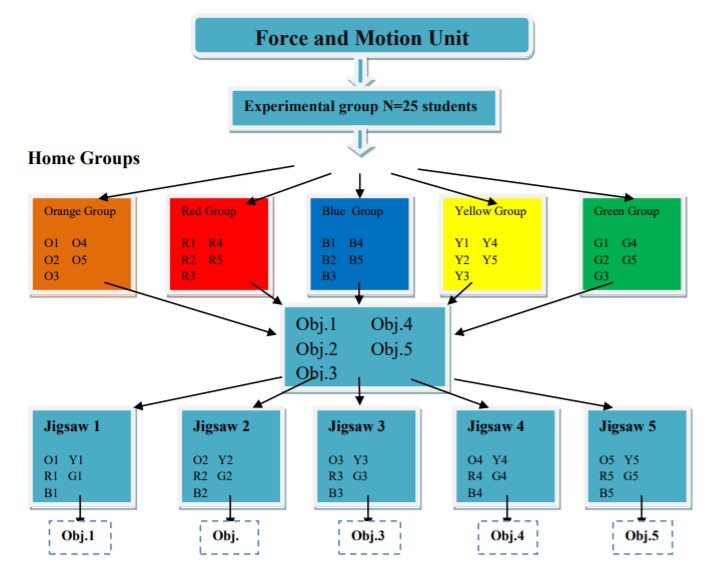Asia-Pacific Forum on Science Learning and Teaching, Volume 18, Issue 1, Article 6 (Jun., 2017) |
The sample of the study consisted of 49 6th grade students from two different classes attending Science and technology course at a government school in Kahramanmaraş/Turkey. The study was conducted in the 2015-2016 Academic year, autumn semester. One of the classes was defined as the control group (N=24) and was taught through the traditional lecturing approach, while the experimental group (N=25) was taught through the cooperative jigsaw technique.
Force and Motion Achievement Test
The Academic Achievement Test (AAT) was prepared by Deveci (2010) through the objectives of the Force and Motion unit for evaluating students’ achievement in the unit. The Test was prepared by considering content validity and in accordance with to expert views in line with the objectives of the unit (Deveci, 2010). The test consisted of 27 multiple choice items and each correct answer was given 1 point, whereas incorrect answers received 0 points. The highest test score that students could get was 1x27=27. The KR-20 analysis was implemented for reliability analysis and the value was calculated to be 0.88 and the KR-21 analysis was implemented and the value was 0.87 for the 27-item test.
Science Learning Motivation Scale
Science Learning Motivation Scale (SLMS) was used to identify students’ motivation for science learning. The scale was developed by Dede and Yaman (2008). Dede and Yaman (2008) administered the scale to 421 students and calculated the Cronbach Alpha reliability coefficient as 0.82. The scale is composed of 23 statements of motivation, 21 of which are positive and 2 are negative. It is a five point likert type scale and the positive statements were coded as “completely agree=5, agree=4, undecided=3, disagree=2 and completely disagree=1”. Negative statements were coded in reverse.
Science Class Attitude Scale
The Science Class Attitude Scale (SCAS) was used to identify the attitudes of students participating in the study towards science class. The scale was developed by Şaşmaz and Ören (2005). The Science and Technology Attitude Scale is composed of 22 attitude statements, 13 of which are positive and 9 are negative statements. It is a five point likert type scale and the positive statements were coded as “completely agree=5, agree=4, undecided=3, disagree=2 and completely disagree=1”. Negative statements were coded in reverse. Reliability analysis was undertaken according to the data obtained from the scale and Şaşmaz and Ören (2005) calculated The Cronbach Alpha coefficient of the scale was calculated to be 0.871.
The Jigsaw Technique View Form
With the purpose of learning about the views of the experiment group students on the implemented jigsaw technique, a form consisting of 6 open-ended questions were prepared. The questions given place to in the form are as follows:
- Was the Force and Motion unit you have implemented with the jigsaw technique permanent?
( ) No.
( ) Yes. Because;………
- In your opinion, should the jigsaw technique application be regularly used in science lessons?
( ) No.
( ) Yes. Because;………
- Do you think the jigsaw technique should be used in other branch classes? Why?
- My interest towards science lesson as a result of the jigsaw technique application has:
( ) increased. Because...
( ) not changed. Because...
( ) decreased. Because....
- Do you think the jigsaw technique has increased your level of success?
- What were the problems you faced while applying the jigsaw technique?
Students from the control group and the jigsaw group studied "force and motion" subject for during six weeks with different instructional methods. The objectives of the "force and motion" unit are given below:
Objective 1: Showing the direction, route and size of a force which affects an object through drawingsObjective 2: Explaining resultant force and showing it through experiments and drawingsObjective 3: Discovering and comparing balanced and unbalanced forces through observing the motion states of objectsObjective 4: Defining speed and expressing its unit.Objective 5: Showing the relationship between distance, time and speed on graphics and interpreting it.The objectives and the content of the subject were the same for both groups. Also, the groups were taught by the same teacher. The experimental group was called the jigsaw group in the study. Since the subject has five objectives, the students in the jigsaw group were divided into 5 heterogeneous home groups. Each home group consisted of 5 students. The home groups were given names. The names of the groups are: Group 1: Orange group, Group 2: Red group, Group 3: Blue group, Group 4: Yellow group, Group 5: Green group Figure 1 displays the jigsaw application.

Figure 1. The Structure of the Jigsaw Application
Prior to the application, the teacher gave information related to cooperative learning and the jigsaw technique. He also explained the learning objectives of the subject. Each of the learning objectives was given to the students in the home groups. The students in a home group were responsible for learning the subject. At first, they came together and made a plan to learn the subject. Each member of a home group was responsible for learning an equal portion of the subject like an expert. This means that each member of a home group was responsible for one of the learning objectives. S/he also was responsible for teaching his/her learning objective to the rest of the group. After sharing the objectives, the home groups broke apart and the students moved into jigsaw groups. The jigsaw groups consisted of members from home groups who were responsible for the same learning objective. In jigsaw groups, the students shared their information and discussed the teaching procedure they would follow. After studying together, the members of the jigsaw groups made a decision. The photographs of the jigsaw application of the students in the experimental groups have been presented in the Appendix.
